Dewoitine D.480
The Dewoitine D.480 was a French single engine side-by-side sports and training aircraft built in the early 1930s. Two were completed and flew with several different radial engines. One remained active through the 1950s.
| Dewoitine D.48 | |
|---|---|
 | |
| Role | Side-by-side sport and training aircraft |
| National origin | France |
| Manufacturer | Constructions Aéronautiques Émile Dewoitine |
| First flight | 1932 |
| Number built | 2 |
Design
The D.480 was designed to a government programme for a side-by-side trainer for flying schools. It was of mixed construction, with a wooden wing and metal fuselage. Its one-piece cantilever low wing was trapezoidal out to elliptical tips, tapered strongly in thickness from root to tip and had significant dihedral. The wing was built around a single spruce and plywood spar and entirely ply skinned. High aspect ratio ailerons filled over half the trailing edges, with ground-adjustable trimming flaps near the roots.[1][2]
The metal-skinned fuselage was based on four longerons, giving it a slightly rounded square cross-section. It was always intended that the D.48 series should be able to accommodate a variety of radial engines in the 67–112 kW (90–150 hp) range and the first prototype, type D.480, had a 71 kW (95 hp) Salmson 7Ac seven cylinder engine in the nose, enclosed in a cowling which exposed its cylinder heads for cooling.[1] A second example, designated D.481, was built at the same time as the first and was identical apart from its 75 kW (100 hp) Lorraine 5Pa radial, similarly cowled.[3] Pilot and pupil sat side by side with dual controls in an open cockpit close to the wing leading edge. Behind them the fuselage tapered to a convention tail. The horizontal tail was roughly elliptical in plan and mounted on top of the fuselage, far enough forward to need only a small space between the elevators for rudder movement. Its deep, full rudder was hinged on a blunted triangular fin.[1]
The D.480 had a fixed, conventional undercarriage with a track of 2.80 m (9 ft 2 in). Each mainwheel was mounted on a stub axle at the vertex of a V-strut hinged on the lower fuselage longeron, with a near-vertical sprung leg, with an oleo strut shock absorber, to the wing spar. The tailwheel was on a long, hinged leg close to the rear fuselage with a short, vertical shock absorber.[1]
Development
Both examples had official pre-flight structural checks made in January 1932;[4] the D.481 at least flew that same month.[3] They were registered as F-AKFF and F-AKFG. One of the pair was displayed at the December 1932 Paris Aero Salon after receiving a 101 kW (135 hp) Salmson 9NC nine-cylinder radial, housed under a long-chord, NACA-style cowling.[5][6] The type number of this variant is not known for certain but recreated French civil aircraft registers show that both spent part of the lives as D.482s.[7]
The register also indicates that one flew for a time as a military aircraft;[8] Dewoitine had argued that it would make a good introductory trainer.[1] It returned to the civil register as F-AQMO in May 1938, operated by an aero club near Toulouse.[8] It survived World War II and in the 1950s, its engine uncowled, carried advertising material for a biscuit manufacturer.[9]
F-AKFG eventually became a type D.483,[7] though little is known about this variant.
Variants
- Dewoitine D.480
- Salmson 7Ac powered, as described. Registered as F-AKFF.
- Dewoitine D.481
- 75 kW (100 hp) Lorraine 5Pa five cylinder radial engine with three blade propeller. Registered as F-AKFG.
- Dewoitine D.482
- D.480 and D.481 re-designated.
- Dewoitine D.483
- Second D.482 re-designated.
Specifications (D.480)
Data from Les Ailes June 1932[1]
General characteristics
- Crew: Two
- Length: 7.395 m (24 ft 3 in)
- Wingspan: 12.700 m (41 ft 8 in)
- Height: 2.830 m (9 ft 3 in)
- Wing area: 19 m2 (200 sq ft) including 2 m2 (22 sq ft) of fuselage underside
- Empty weight: 646 kg (1,424 lb) equipped, without fuel
- Gross weight: 909 kg (2,004 lb)
- Fuel capacity: 120 l (26 imp gal; 32 US gal)
- Powerplant: 1 × Salmson 7Ac 7-cylinder air-cooled radial, 71 kW (95 hp)
- Propellers: 2-bladed
Performance
- Maximum speed: 175 km/h (109 mph, 94 kn) at ground level
- Minimum control speed: 84 km/h (52 mph, 45 kn)
- Range: 600 km (370 mi, 320 nmi)
- Service ceiling: 4,500 m (14,800 ft)
References
- Frachet, André (23 June 1932). "Le monoplan Dewoitine D. 48". Les Ailes (575): 3.
- "Le biplace côte à côte Dewoitine 480". L'Aéronautique (385): 360. December 1932.
- Bruno Parmentier. "Dewoitine D.481". Retrieved 18 February 2004.
- Frachet, André (14 January 1932). "D'aérodrome en aérodrome - À Toulouse-Francazal". Les Ailes (552): 12.
- Hirschauer, L.; Dolfus, Ch (1933). Le Année Aéronautique 1932-1933. London: Dunod. p. 214.
- Frachet, André (December 1932). "L'avion école Dewoitine". L'Aérophile. 40 (XII): 360.
- Martin, Bernard; Sparrow, Dave; Espérou, Robert (September 2012). "The French civil register from 1922". Air Britain Archive: 2012/135.
- "Golden Years of Aviation". Retrieved 2 November 2015.
- "Dewoitine 482 no.1 F-AQMO". Retrieved 13 July 2016.